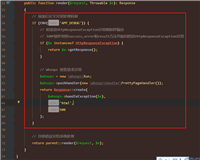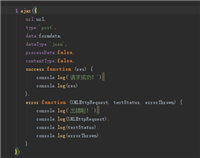之前编译安装的lnmp环境+phpmyamdin4.02的版本,今天突然出现这个问题:
fatal error: session_start(): failed to initialize storage module: files (path: ) in /data/www/phpmyadmin/libraries/session.inc.php on line 83
大致意思是session会话初始化的时候储存路径有误!第一反应就是查看php.ini的配置文件中的:
session.save_path = "/tmp"
默认前面是加的分号,表示不启用,我之前配置的时候已经启用了。那为什么还会报错呢?,于是网上找了一些资料,感觉都千篇一律:
1、检查error.log(apache2.2\logs)文件,查看是否有错误报告。未发现。
2、检查php.ini中的session.save_handler的值是否为files,如果不是改为files
3、检查php.ini文件中session.save_path是否被注释了,如果有,则去掉前面的”;”。
4、将save_path后面的路径改成已有的路径,比如”d:\php\temp”
5、检查temp文件夹的属性是否可读可写。
6、重启apache服务器。ok
不知道那些哥们转载的时候自己试过了没有(在这里喷一下,最讨厌那种自己都没有亲测,就一股脑的转来转去。一点都不负责!)
根据上面的流程,排查了之后发现压根就没有解决,不过小编的服务器是nginx非apache。
然后自己写了一个脚本test.php:
$r = session_start();
var_dump($r);
打印结果为:
warning: session_start(): safe mode restriction in effect. the script whose uid is 501 is not allowed to access /tmp owned by uid 0 in /data/www/test.php on line 3 fatal error: session_start(): failed to initialize storage module: files (path: ) in /data/www/test.php on line 3
意思是 php5一个安全模式的bug,默认session的save_path是系统的临时目录,这样会要校验权限。而这个脚本不能通过/tmp拥有者uid为0来执行uid是501也是www用户组的权限
解决这个有两种解决方法:
1.关闭安全模式;
2.在命令行下chown改文件/目录的拥有者
当然两种方法都要求你有服务器的权限。
下面是示例php.ini的配置文件:
[session]
; handler used to store/retrieve data.
; http://php.net/session.save-handler
session.save_handler = files; argument passed to save_handler. in the case of files, this is the path
; where data files are stored. note: windows users have to change this
; variable in order to use php's session functions.
; the path can be defined as:
; session.save_path = "n;/path"
; where n is an integer. instead of storing all the session files in
; /path, what this will do is use subdirectories n-levels deep, and
; store the session data in those directories. this is useful if you
; or your os have problems with lots of files in one directory, and is
; a more efficient layout for servers that handle lots of sessions.
; note 1: php will not create this directory structure automatically.
; you can use the script in the ext/session dir for that purpose.
; note 2: see the section on garbage collection below if you choose to
; use subdirectories for session storage
; the file storage module creates files using mode 600 by default.
; you can change that by using
; session.save_path = "n;mode;/path"
; where mode is the octal representation of the mode. note that this
; does not overwrite the process's umask.
; http://php.net/session.save-path
session.save_path = "/tmp"
; whether to use cookies.
; http://php.net/session.use-cookies
session.use_cookies = 1
; http://php.net/session.cookie-secure
;session.cookie_secure =
; this option forces php to fetch and use a cookie for storing and maintaining
; the session id. we encourage this operation as it's very helpful in combatting
; session hijacking when not specifying and managing your own session id. it is
; not the end all be all of session hijacking defense, but it's a good start.
; http://php.net/session.use-only-cookies
session.use_only_cookies = 1
; name of the session (used as cookie name).
; http://php.net/session.name
session.name = phpsessid
; initialize session on request startup.
; http://php.net/session.auto-start
session.auto_start = 0
; lifetime in seconds of cookie or, if 0, until browser is restarted.
; http://php.net/session.cookie-lifetime
session.cookie_lifetime = 0
; the path for which the cookie is valid.
; http://php.net/session.cookie-path
session.cookie_path = /
; the domain for which the cookie is valid.
; http://php.net/session.cookie-domain
session.cookie_domain =
; whether or not to add the httponly flag to the cookie, which makes it inaccessible to browser scripting languages such as javascript.
; http://php.net/session.cookie-httponly
session.cookie_httponly =
; handler used to serialize data. php is the standard serializer of php.
; http://php.net/session.serialize-handler
session.serialize_handler = php
; defines the probability that the 'garbage collection' process is started
; on every session initialization. the probability is calculated by using
; gc_probability/gc_divisor. where session.gc_probability is the numerator
; and gc_divisor is the denominator in the equation. setting this value to 1
; when the session.gc_divisor value is 100 will give you approximately a 1% chance
; the gc will run on any give request.
; default value: 1
; development value: 1
; production value: 1
; http://php.net/session.gc-probability
session.gc_probability = 1
; defines the probability that the 'garbage collection' process is started on every
; session initialization. the probability is calculated by using the following equation:
; gc_probability/gc_divisor. where session.gc_probability is the numerator and
; session.gc_divisor is the denominator in the equation. setting this value to 1
; when the session.gc_divisor value is 100 will give you approximately a 1% chance
; the gc will run on any give request. increasing this value to 1000 will give you
; a 0.1% chance the gc will run on any give request. for high volume production servers,
; this is a more efficient approach.
; default value: 100
; development value: 1000
; production value: 1000
; http://php.net/session.gc-divisor
session.gc_divisor = 1000
; after this number of seconds, stored data will be seen as 'garbage' and
; cleaned up by the garbage collection process.
; http://php.net/session.gc-maxlifetime
session.gc_maxlifetime = 1440
; note: if you are using the subdirectory option for storing session files
; (see session.save_path above), then garbage collection does *not*
; happen automatically. you will need to do your own garbage
; collection through a shell script, cron entry, or some other method.
; for example, the following script would is the equivalent of
; setting session.gc_maxlifetime to 1440 (1440 seconds = 24 minutes):
; find /path/to/sessions -cmin +24 | xargs rm
; php 4.2 and less have an undocumented feature/bug that allows you to
; to initialize a session variable in the global scope, even when register_globals
; is disabled. php 4.3 and later will warn you, if this feature is used.
; you can disable the feature and the warning separately. at this time,
; the warning is only displayed, if bug_compat_42 is enabled. this feature
; introduces some serious security problems if not handled correctly. it's
; recommended that you do not use this feature on production servers. but you
; should enable this on development servers and enable the warning as well. if you
; do not enable the feature on development servers, you won't be warned when it's
; used and debugging errors caused by this can be difficult to track down.
; default value: on
; development value: on
; production value: off
; http://php.net/session.bug-compat-42
session.bug_compat_42 = off
; this setting controls whether or not you are warned by php when initializing a
; session value into the global space. session.bug_compat_42 must be enabled before
; these warnings can be issued by php. see the directive above for more information.
; default value: on
; development value: on
; production value: off
; http://php.net/session.bug-compat-warn
session.bug_compat_warn = off
; check http referer to invalidate externally stored urls containing ids.
; http_referer has to contain this substring for the session to be
; considered as valid.
; http://php.net/session.referer-check
session.referer_check =
; how many bytes to read from the file.
; http://php.net/session.entropy-length
session.entropy_length = 0
; specified here to create the session id.
; http://php.net/session.entropy-file
; on systems that don't have /dev/urandom /dev/arandom can be used
; on windows, setting the entropy_length setting will activate the
; windows random source (using the cryptoapi)
;session.entropy_file = /dev/urandom
; set to {nocache,private,public,} to determine http caching aspects
; or leave this empty to avoid sending anti-caching headers.
; http://php.net/session.cache-limiter
session.cache_limiter = nocache
; document expires after n minutes.
; http://php.net/session.cache-expire
session.cache_expire = 180
; trans sid support is disabled by default.
; use of trans sid may risk your users security.
; use this option with caution.
; - user may send url contains active session id
; to other person via. email/irc/etc.
; - url that contains active session id may be stored
; in publically accessible computer.
; - user may access your site with the same session id
; always using url stored in browser's history or bookmarks.
; http://php.net/session.use-trans-sid
session.use_trans_sid = 0
; select a hash function for use in generating session ids.
; possible values
; 0 (md5 128 bits)
; 1 (sha-1 160 bits)
; this option may also be set to the name of any hash function supported by
; the hash extension. a list of available hashes is returned by the hash_algos()
; function.
; http://php.net/session.hash-function
session.hash_function = 0
; define how many bits are stored in each character when converting
; the binary hash data to something readable.
; possible values:
; 4 (4 bits: 0-9, a-f)
; 5 (5 bits: 0-9, a-v)
; 6 (6 bits: 0-9, a-z, a-z, "-", ",")
; default value: 4
; development value: 5
; production value: 5
; http://php.net/session.hash-bits-per-character
session.hash_bits_per_character = 5
; the url rewriter will look for urls in a defined set of html tags.
; form/fieldset are special; if you include them here, the rewriter will
; add a hidden <input> field with the info which is otherwise appended
; to urls. if you want xhtml conformity, remove the form entry.
; note that all valid entries require a "=", even if no value follows.
; default value: "a=href,area=href,frame=src,form=,fieldset="
; development value: "a=href,area=href,frame=src,input=src,form=fakeentry"
; production value: "a=href,area=href,frame=src,input=src,form=fakeentry"
; http://php.net/url-rewriter.tags
url_rewriter.tags = "a=href,area=href,frame=src,input=src,form=fakeentry"
因为这个是在一台vps上面配置的,上面有多个项目,于是小编打开一个项目,发现此项目的验证码功能是ok的。
于是查看代码如下:
$sesssavepath = "/data/sessions/";
// session保存路径
if(is_writeable($sesssavepath) && is_readable($sesssavepath)){ session_save_path($sesssavepath); }
if(!empty($cfg_domain_cookie)) session_set_cookie_params(0,'/',$cfg_domain_cookie);
上面这个代码是在session_start() 初始化之前来判断是否存在session会话的文件夹。
于是就在phpmyadmin里面的保存的那个文件/phpmyadmin/libraries/session.inc.php做了下修改:
if (! isset($_cookie[$session_name])) {
// on first start of session we check for errors
// f.e. session dir cannot be accessed - session file not created
$orig_error_count = $globals['error_handler']->counterrors();
//session_save_path('./tmp');
session_save_path("/data/www/session");
$r = session_start();
if ($r !== true
|| $orig_error_count != $globals['error_handler']->counterrors()
) {
setcookie($session_name, '', 1);
/*
* session initialization is done before selecting language, so we
* can not use translations here.
*/
pma_fatalerror('cannot start session without errors, please check errors given in your php and/or webserver log file and configure your php installation properly. also ensure that cookies are enabled in your browser.');
}
unset($orig_error_count);
} else {
session_save_path("/data/www/session");
session_start();
}
在 session_start(); 前面添加了 session_save_path(“/data/www/session”); 就解决了这个问题。
切记通过@ini_set(‘session.save_path', ”/data/www/session”);无效!
这个问题困扰了我几个小时,终于解决了,所以就记录下来,对日后应该会有帮助。
如对本文有疑问,
点击进行留言回复!!




网友评论